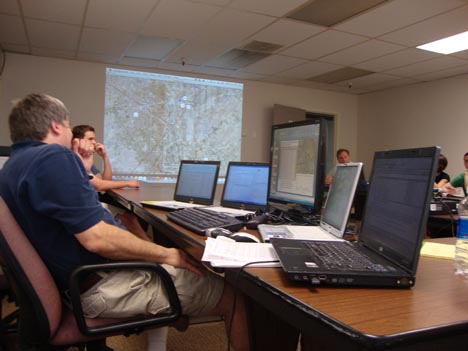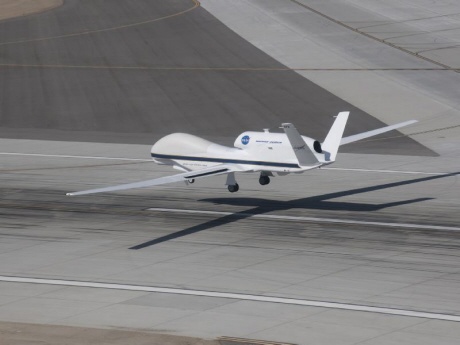

Normally, flight patterns are designed and effectuated based upon good scientific conditions. We must rely on the expertise of meteorologists who tell us if we are likely to fly with favorable weather. Instruments being all “go” is another fundamentally important factor (the first day we were grounded by power problems to one of the aircraft). In campaigns like CARES, where day by day several airplanes coordinate their trajectories, even the crew rest days play a significant role. That is to say that it gets some time to get things rolling, especially in the beginning of a mission.
We managed to have our first flight yesterday. Even though the meteorological conditions haven’t been ideal so far (euphemism), having flown over R/V Atlantis was a notable achievement. The ship is owned by the United States Navy and operated by the Woods Hole Oceanographic Institution, and it navigated up the Sacramento River carrying many instruments to measure pollutants. Follow this link to find out the location of the ship, or this other one if you want to plot the data the ship is collecting in real time!

Today, the McClellan airfield is hosting the sorrow return of a military airplane carrying a victim from Afghanistan. Although eager to fly, in an almost silent debate we designated this as a “hard day down” before hand. That means no takeoff. One of the things you learn from the field: this is the real world.
-Matteo
First day on the field. I made it to McClellan airfield (with luggage lost of course). Off-course! So many things to do, trying to get my bearings and making sure I know who is who.
Guess what? I have a fellow blogger! Rahul Zaveri, the principal investigator of the mission, is posting regular updates on the Pacific Northwestern National Laboratory website.

We must mention here that CARES is actually happening simultaneously to CalNex, a big effort involving the California Air Resources Board (CARB), the National Oceanic and Atmospheric Administration (NOAA) and the California Energy Commission (CEC).
Several aircraft and vessels at sea have been deployed since May over California and the Eastern Pacific coastal region, collecting data to study the relation between air quality and climate change. Lots of folks have been working around the clock during the last month. That part of the campaign staged Ontario, CA as a base camp and lots of aerosols were detected and monitored in Southern California.
On another note, I checked out the Biennial at the Whitney Museum in New York City’s Upper East Side last weekend. Huge noise on the second floor, and I followed it. It led me to Ari Marcopoulos‘ installation, a simple home-made video called “Detroit”. It carefully portrayed two kids creating all sort of bzzzzzz–waa-waa-ffoossshhhhh-skrrreeeeek sounds by gently whacking old transistor amps and skillfully acting on the knobs of guitar distortion pedals.
I’ll let you guess until a later post why bzzzzzz–waa-waa-ffoossshhhhh-skrrreeeeek reminded me of CARES. I can just see you sizzling with trepidation already….
Matteo Ottaviani, NASA GISS

We — the scientists taking part in the Carbonaceous and Aerosol Radiative Effects Study (CARES), a field campaign to California that’s all about aerosols – do, that’s who.
Walk outside, lift your eyes and look: what do you see?
If you’re lucky, not much more than a beautiful blue sky. More likely, though, you’ll be looking out on a smoggy veil of haze as most of us live in big cities with plenty of air pollution. If you’re on a boat you might see sea spray, or if you just happen to be riding a camel in the Sahara you might spot specks of dust blowing in the wind. They’re all types of aerosols, as we call pretty much any kind of particle suspended in the atmosphere.
How about pollen particles floating around in the air during the spring? Or the dark plume of ash coming out of Eyjafjallajokull?

Yep, aerosols as well. And that ash from Iceland brings about another important point. Aerosols move around for weeks transported by winds: indeed, inhabitants of the Caribbean don’t necessarily need to be riding the aforementioned camel to observe Saharan dust, since winds systematically transport it across the Pond. Wildfire smoke and Asian pollution share similar long-transport fates. The shape and composition of aerosols even change as a consequence of the conditions in the air.
Aerosols have long been of interest because of the health problems they cause and because they apparently have a tendency to ground flights in Europe. Nowadays, they’re also a super hot topic in the science world, because their influence on climate is not well understood or quantified.
Most aerosols reflect incoming sunbeams, sending them off back to space. Cool. Literally (we call that a “cooling effect”). Recently much interest revolves around the fraction of those that actually absorb some light from the Sun, therefore contributing to a local warming of the atmosphere.
What’s the ultimate effect? That’s a big question to answer, a question for anybody who CARES. A team of scientists —including yours truly— is heading off to California to study the evolution of aerosol life. We’ll be blogging regularly from the field, so come along for the ride…

–Matteo Ottaviani, NASA GISS
From GloPac co-mission scientist Paul Newman:
It was a tense moment on Friday morning, April 2. The Global Hawk was poised on the end of the runway, with the crew chief behind it in a pick-up truck (“the trapper” is the runway-based eyes and ears for the crew in the control room). Pilots, managers, and scientists sat in the darkened Global Hawk Operations Center (GHOC), intently staring at their computer screens and the LCD monitors.
At 6:56 AM Pacific, the pilots commanded the takeoff from their computer and we watched the Global Hawk begin to accelerate down the runway. We listened over our head-sets as the trapper followed the jet and called out it’s speed. We watched the screen as the plane gently lifted off the runway and soared towards the stratosphere. As the Global Hawk lifted off, the scientists in the GHOC’s payload operations room broke into applause.
Why did we applaud? Two reasons. First, everyone was happy that we were flying after three weeks of hard work installing our instruments and solving a myriad of hardware and software problems.
Second, and more importantly, it was applause for the engineers, managers, and crew of the Global Hawk. Chris Naftel and his Dryden team have made the Global Hawk a reality for science.

This was an historic occasion — the first test flight of the Global Hawk carrying a science payload. This flight ushers in a new era that combines state-of-the-art aircraft hardware and science instruments with software — a hybrid of satellites and aircraft for future science. I imagine that in the future there will be fleets of these aircraft probing our atmosphere and providing information for weather forecasting, hurricane reconnaissance, ozone depletion, and climate change.
Dr. Robert Bindschadler reports on progress from his team’s work this past Antarctic summer. The project took a major step forward in 2010, although the work that was accomplished was completed far from the Pine Island area. The goal was to conduct field work together for the first time, try out as many techniques as possible and test as much equipment as we could. Looking forward to a return to Pine Island ice shelf in 2011-12.
Read more on the Pine Island Glacier site.
